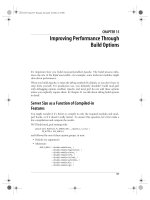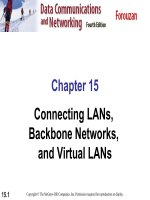Chapter 15: Internetwork Protocols pot
Bạn đang xem bản rút gọn của tài liệu. Xem và tải ngay bản đầy đủ của tài liệu tại đây (331.66 KB, 71 trang )
William Stallings
Data and Computer
Communications
Chapter 15
Internetwork Protocols
Internetworking Terms (1)
❚
Communications Network
❙
Facility that provides data transfer service
❚
An internet
❙
Collection of communications networks interconnected by
bridges and/or routers
❚
The Internet - note upper case I
❙
The global collection of thousands of individual machines and
networks
❚
Intranet
❙
Corporate internet operating within the organization
❙
Uses Internet (TCP/IP and http)technology to deliver
documents and resources
Internetworking Terms (2)
❚
End System (ES)
❙
Device attached to one of the networks of an internet
❙
Supports end-user applications or services
❚
Intermediate System (IS)
❙
Device used to connect two networks
❙
Permits communication between end systems
attached to different networks
Internetworking Terms (3)
❚
Bridge
❙
IS used to connect two LANs using similar LAN
protocols
❙
Address filter passing on packets to the required
network only
❙
OSI layer 2 (Data Link)
❚
Router
❙
Connects two (possibly dissimilar) networks
❙
Uses internet protocol present in each router and end
system
❙
OSI Layer 3 (Network)
Internetworking Protocols
Requirements of
Internetworking
❚
Link between networks
❙
Minimum physical and link layer
❚
Routing and delivery of data between processes
on different networks
❚
Accounting services and status info
❚
Independent of network architectures
Network Architecture Features
❚
Addressing
❚
Packet size
❚
Access mechanism
❚
Timeouts
❚
Error recovery
❚
Status reporting
❚
Routing
❚
User access control
❚
Connection based or connectionless
Architectural Approaches
❚
Connection oriented
❚
Connectionless
Connection Oriented
❚
Assume that each network is connection
oriented
❚
IS connect two or more networks
❙
IS appear as DTE to each network
❙
Logical connection set up between DTEs
❘
Concatenation of logical connections across networks
❙
Individual network virtual circuits joined by IS
❚
May require enhancement of local network
services
❙
802, FDDI are datagram services
Connection Oriented IS
Functions
❚
Relaying
❚
Routing
❚
e.g. X.75 used to interconnect X.25 packet
switched networks
❚
Connection oriented not often used
❙
(IP dominant)
Connectionless Operation
❚
Corresponds to datagram mechanism in packet
switched network
❚
Each NPDU treated separately
❚
Network layer protocol common to all DTEs and
routers
❙
Known generically as the internet protocol
❚
Internet Protocol
❙
One such internet protocol developed for ARPANET
❙
RFC 791 (Get it and study it)
❚
Lower layer protocol needed to access particular
network
Connectionless
Internetworking
❚
Advantages
❙
Flexibility
❙
Robust
❙
No unnecessary overhead
❚
Unreliable
❙
Not guaranteed delivery
❙
Not guaranteed order of delivery
❘
Packets can take different routes
❙
Reliability is responsibility of next layer up (e.g. TCP)
IP Operation
Design Issues
❚
Routing
❚
Datagram lifetime
❚
Fragmentation and re-assembly
❚
Error control
❚
Flow control
Routing
❚
End systems and routers maintain routing tables
❙
Indicate next router to which datagram should be sent
❙
Static
❘
May contain alternative routes
❙
Dynamic
❘
Flexible response to congestion and errors
❚
Source routing
❙
Source specifies route as sequential list of routers to be
followed
❙
Security
❙
Priority
❚
Route recording
Datagram Lifetime
❚
Datagrams could loop indefinitely
❙
Consumes resources
❙
Transport protocol may need upper bound on datagram life
❚
Datagram marked with lifetime
❙
Time To Live field in IP
❙
Once lifetime expires, datagram discarded (not forwarded)
❙
Hop count
❘
Decrement time to live on passing through a each router
❙
Time count
❘
Need to know how long since last router
❚
(Aside: compare with Logan’s Run)
Fragmentation and
Re-assembly
❚
Different packet sizes
❚
When to re-assemble
❙
At destination
❘
Results in packets getting smaller as data traverses internet
❙
Intermediate re-assembly
❘
Need large buffers at routers
❘
Buffers may fill with fragments
❘
All fragments must go through same router
•
Inhibits dynamic routing
IP Fragmentation (1)
❚
IP re-assembles at destination only
❚
Uses fields in header
❙
Data Unit Identifier (ID)
❘
Identifies end system originated datagram
•
Source and destination address
•
Protocol layer generating data (e.g. TCP)
•
Identification supplied by that layer
❙
Data length
❘
Length of user data in octets
IP Fragmentation (2)
❙
Offset
❘
Position of fragment of user data in original datagram
❘
In multiples of 64 bits (8 octets)
❙
More
flag
❘
Indicates that this is not the last fragment
Fragmentation Example
Dealing with Failure
❚
Re-assembly may fail if some fragments get lost
❚
Need to detect failure
❚
Re-assembly time out
❙
Assigned to first fragment to arrive
❙
If timeout expires before all fragments arrive, discard
partial data
❚
Use packet lifetime (time to live in IP)
❙
If time to live runs out, kill partial data
Error Control
❚
Not guaranteed delivery
❚
Router should attempt to inform source if packet
discarded
❙
e.g. for time to live expiring
❚
Source may modify transmission strategy
❚
May inform high layer protocol
❚
Datagram identification needed
❚
(Look up ICMP)
Flow Control
❚
Allows routers and/or stations to limit rate of
incoming data
❚
Limited in connectionless systems
❚
Send flow control packets
❙
Requesting reduced flow
❚
e.g. ICMP
Internet Protocol (IP)
❚
Part of TCP/IP
❙
Used by the Internet
❚
Specifies interface with higher layer
❙
e.g. TCP
❚
Specifies protocol format and mechanisms
IP Services
❚
Primitives
❙
Functions to be performed
❙
Form of primitive implementation dependent
❘
e.g. subroutine call
❙
Send
❘
Request transmission of data unit
❙
Deliver
❘
Notify user of arrival of data unit
❚
Parameters
❙
Used to pass data and control info









